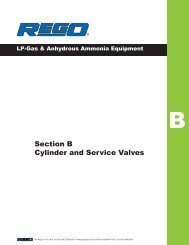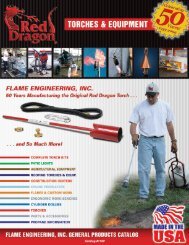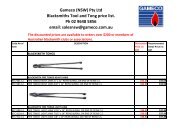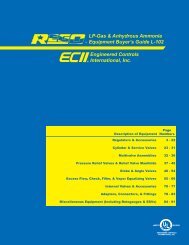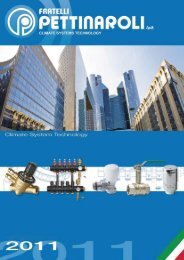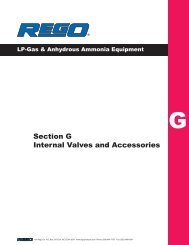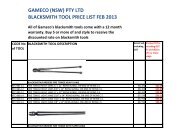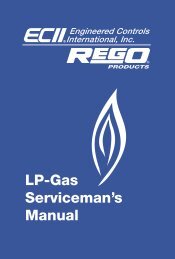Repair Kits Available By Part Number Section 2 Page - GAMECO
Repair Kits Available By Part Number Section 2 Page - GAMECO
Repair Kits Available By Part Number Section 2 Page - GAMECO
Create successful ePaper yourself
Turn your PDF publications into a flip-book with our unique Google optimized e-Paper software.
WARNING: Installation, disassembly, repair and maintenance<br />
must be performed only by qualified personnel.<br />
All gas should be evacuated from the system before starting<br />
repairs. Remove the entire valve before performing repairs.<br />
Emergency service on the lower stem assembly portion of the<br />
valve only, may be carried out with the valve installed, provided<br />
downstream pressure is relieved under the same conditions<br />
required for releasing LP-Gas, as in the caution below, and that<br />
there is positive assurance that the valve is closed tight with<br />
no leakage past the seats.<br />
Installation, usage and maintenance of this product must be in<br />
compliance with all Engineered Controls International, Inc.<br />
instructions as well as requirements and provisions of NFPA<br />
#54, NFPA #58, DOT, ANSI, all applicable federal, state, provincial<br />
and local standards, codes, regulations and laws.<br />
Inspection and maintenance on a periodic basis is essential.<br />
Be sure all instructions are read and understood before installation,<br />
operation and maintenance. These instructions must be<br />
passed along to the end user of the product.<br />
CAUTION: Contact or inhalation of liquid propane, ammonia<br />
and their vapors can cause serious injury or death! NH3and LP-<br />
Gas must be released outdoors in air currents that will insure<br />
dispersion to prevent exposure to people and livestock. LP-<br />
Gas must be kept far enough from any open flame or other<br />
source of ignition to prevent fire or explosion! LP-Gas is<br />
heavier than air and may not disperse or evaporate rapidly if<br />
released in still air.<br />
Disassembly and <strong>Repair</strong> Procedure<br />
CAUTION: READ THROUGH ALL OF THESE INSTRUCTIONS, IN-<br />
CLUDING THE NOTICE AND WARNINGS ON THE BACK OF THIS<br />
SHEET, BEFORE BEGINNING ANY DISASSEMBLY OR REPAIR.<br />
NOTE: Before repairing valve , thoroughly examine valve lever and<br />
all associated parts for excessive wear. Check handle for proper<br />
function and flange seating surfaces for excessive wear and<br />
damage. Any components that are not in good condition and not<br />
fully operational should be replaced during repairs.<br />
<strong>Repair</strong>s must be performed in a clean area. Hands, clothing, tools and<br />
work area must be completely free of oil, grease and foreign matter to<br />
prevent contamination of component parts and valves.<br />
A. Disassembly<br />
NOTE: The Standard A3217 Series valve is equipped with a manual<br />
actuator. It is possible that the valve under repair has been fitted with<br />
a pneumatic actuator. Please follow the disassembly and reassembly<br />
procedures for the appropriate actuator.<br />
1. Remove the valve actuator.<br />
Manual Actuator:<br />
a. Remove the cotter pin from the handle/stem assembly that is<br />
located in the outer most area of the stem. Save for reassembly.<br />
b. Loosen and remove steel bolt from the stem. Save bolt and<br />
washer for reassembly.<br />
c. Remove handle from stem. Save for reassembly.<br />
Pneumatic actuator:<br />
a. Remove cotter pin from pivot pin, located behind the clevis, and<br />
save for reassembly. Remove the pivot pin and washers. Save<br />
parts for reassembly.<br />
b. To remove crank arm, first remove cotter pin from crank arm and<br />
discard. Rotate the crank arm counterclockwise until the leg<br />
clears the clevis. Pull the crank arm off the stem. Remove nylon<br />
washer. Retain all parts.<br />
c. Remove and retain bracket screws and bracket lock washers.<br />
The actuator bracket can now be removed and saved.<br />
2. Using a 1 3 /8" wrench, completely loosen and carefully remove the<br />
seal gland and stem assembly from the valve.<br />
CAUTION: Use special care not to damage stem or any other<br />
parts of the valve.<br />
3. Remove the stem spring, stem washer, jam ring, and (3) stem seals<br />
from the seal gland. Discard all parts except the seal gland.<br />
4. Remove stem O-ring, dust seal, and outer stem bearing from seal<br />
gland. Discard stem O-ring and dust seal. Save outer stem bearing<br />
and seal gland for reassembly.<br />
5. Check the stem seal gland and stem for excessive wear and/or<br />
damage. Replace if necessary.<br />
B. Reassembly<br />
NOTE: Clean all parts prior to reassembly when lubrication is required<br />
use a hydrolith grease compound, not included. Apply all lubricant as<br />
a thin film.<br />
Diagram — 1<br />
Valve Body<br />
Stem<br />
Inner Stem Bearing<br />
* Stem Spring<br />
* Stem Washer<br />
* Jam Ring<br />
* Stem Seals (3)<br />
Seal Gland<br />
Outer Stem Bearing<br />
* Stem O-Ring<br />
* Dust Seal<br />
Cotter Pin<br />
Washer<br />
Steel Bolt<br />
Handle<br />
* Indicates <strong>Part</strong>s included in A3217F-50 <strong>Repair</strong> Kit.



